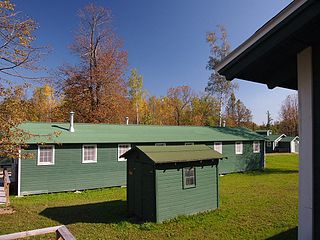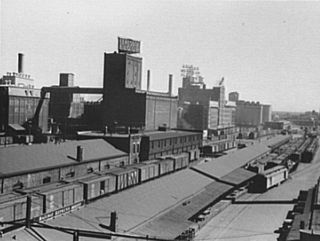
Saint Anthony Falls, or the Falls of Saint Anthony, located at the northeastern edge of downtown Minneapolis, Minnesota, is the only natural major waterfall on the Mississippi River. Throughout the mid-to-late 1800s, various dams were built atop the east and west faces of the falls to support the milling industry that spurred the growth of the city of Minneapolis. In 1880, the central face of the falls was reinforced with a sloping timber apron to stop the upstream erosion of the falls. In the 1950s, the apron was rebuilt with concrete, which makes up the most visible portion of the falls today. A series of locks were constructed in the 1950s and 1960s to extend navigation to points upstream.

Minneapolis City Hall and Hennepin County Courthouse, designed by Long and Kees in 1888, is the main building used by the city government of Minneapolis, as well as by Hennepin County, in the U.S. state of Minnesota. The structure has served as mainly local government offices since it was built, and today the building is 60 percent occupied by the city and 40 percent occupied by the County. The building is jointly owned by the city and county and managed by the Municipal Building Commission. The Commission consists of the chair of the County Board, the mayor of the City of Minneapolis, a member of the County Board and a member of the Minneapolis City Council. The County Board chair serves as the president of the Commission and the mayor serves as the vice president. The building bears a striking resemblance to the city hall buildings in Cincinnati and Toronto. The City Hall and Courthouse was added to the National Register of Historic Places in 1974.

Nicodemus National Historic Site, located in Nicodemus, Kansas, United States, preserves, protects and interprets the only remaining western town established by African Americans during the Reconstruction Period following the American Civil War. The town of Nicodemus is symbolic of the pioneer spirit of African Americans who dared to leave the only region they had been familiar with to seek personal freedom and the opportunity to develop their talents and capabilities. The site was named, at least in part, for a legendary African-American slave featured in abolitionist Henry Clay Work's "Wake, Nicodemus (1864)." It is a mystical story of an old slave died away and buried in a hollow tree who had asked to be awakened on the Day of Jubilee.

Saint Anthony Main refers to an area of buildings with multiple owners located on Main Street across from Saint Anthony Falls in the Nicollet Island/East Bank, Minneapolis section of Southeast, Minneapolis in the U.S. state of Minnesota. Commonly the area is associated with Northeast, Minneapolis as it is actually northeast of downtown on the east side of the Mississippi River. It opened as a festival marketplace in the 1980s.

West Overton is located approximately 40 miles (64 km) southeast of Pittsburgh, in East Huntingdon Township, Westmoreland County, Pennsylvania, United States. It is on PA 819 between the towns of Mount Pleasant and Scottdale. Its latitude is 40.117N and its longitude is -79.564W.

Oatlands Historic House and Gardens is an estate located in Leesburg, Virginia. Oatlands is operated by the National Trust for Historic Preservation and is listed on the National Register of Historic Places as a National Historic Landmark. The Oatlands property is composed of the main mansion and 415 acres of farmland and gardens. The house is judged one of the finest Federal period country estate houses in the nation.

The Rabideau CCC Camp was a Civilian Conservation Corps (CCC) camp in the Chippewa National Forest in northern Minnesota, United States. It is located off Beltrami County Highway 39, in Taylor Township, and is one of the best-preserved of the nation's many CCC camps. A National Historic Landmark, it now serves as an educational center.

Minneapolis is the largest city by population in the U.S. state of Minnesota, and the county seat of Hennepin County. The origin and growth of the city was spurred by the proximity of Fort Snelling, the first major United States military presence in the area, and by its location on Saint Anthony Falls, which provided power for sawmills and flour mills.

Northwestern Consolidated Milling Company was an American flour milling company that operated about one-quarter of the mills in Minneapolis, Minnesota, when the city was the flour milling capital of the world. Formed as a business entity, Northwestern produced flour for the half-century between 1891 and 1953, when its A Mill was converted to storage and light manufacturing. At its founding, Northwestern was the city's and the world's second-largest flour milling company after Pillsbury, with what is today General Mills a close third. The company became one of three constituents of a Minneapolis oligopoly that owned almost nine percent of the country's flour and grist production and products by 1905. This occurred as a result of their attempt at a United States monopoly.

The North Star Woolen Mill, now the North Star Lofts, is a building in downtown Minneapolis, Minnesota, United States. The building, located in the St. Anthony Falls Historic District, was originally a textile mill for the North Star Woolen Company. The mill was built in 1864 by W.W. Eastman and Paris Gibson on the west side of the west side canal. High quality wool blankets, scarves, flannels, and yarns were manufactured at the facility and it became the nation's largest manufacturer of wool blankets by 1925.

The following are all the contributing resources to the Saint Anthony Falls Historic District in Minneapolis, Minnesota, United States. The District is listed on the National Register of Historic Places, thus these properties are on the NRHP. The "period of significance" of the District was 1858–1941. The district's archaeological record is considered to be one of the most-endangered historic sites in Minnesota.

The John Harrington Stevens House is a historic structure in the U.S. state of Minnesota. Named for John H. Stevens, it was the first authorized house on the west bank of the Mississippi River in what would become Minneapolis. The house is the second oldest remaining wood-frame house in Minneapolis. The house is part of the Minnehaha Historic District and managed by the Minneapolis Park and Recreation Board. The structure was heavily damaged by three acts of arson in 2022.
Hamilton's Stores were concessioners in Yellowstone National Park from 1915 to 2002. The stores were founded by Winnipeg native Charles Hamilton, who arrived in Yellowstone in 1905, aged 21, to work for the Yellowstone Park Association. The stores provided tourists with food, souvenirs, and sundries at the major attractions along Yellowstone's Grand Loop Road. Several buildings constructed for Hamilton are significant examples of the National Park Service Rustic style of architecture and have assumed prominence as attractions in their own right. Most are included as contributing structures in National Register of Historic Places historic districts.

Mill City Museum is an American Minnesota Historical Society museum in Minneapolis. It opened in 2003 built in the ruins of the Washburn "A" Mill next to Mill Ruins Park on the banks of the Mississippi River. The museum focuses on the founding and growth of Minneapolis, especially flour milling and the other industries that used hydropower from Saint Anthony Falls.
Sion Hill is a settlement on the island of Saint Croix, in the United States Virgin Islands.

The Nyce Farm, also known as the Eshback Farm and Van Gordon House, is an historic, American home and farm complex that is located in the Delaware Water Gap National Recreation Area in Lehman Township, Pike County, Pennsylvania.

The Spring Mill Complex, also known as the Gunkle Spring Mill, is a historic American gristmill complex constructed in 1793. The complex is located in East Whiteland Township, Chester County, Pennsylvania. It was listed on the National Register of Historic Places in 1978.

City of Camden Historic District is a national historic district located at Camden, Kershaw County, South Carolina. The district encompasses 48 contributing buildings, 8 contributing sites, 2 contributing structures, and 3 contributing objects in Camden. The district is mostly residential but also include public buildings, a church, and a cemetery. Camden's architecture is classically inspired and includes examples of Federal, Greek Revival, and Classical Revival, in addition to cottage-type, Georgian, Charleston-type with modifications, and mansion-type houses. Several of the city's buildings were designed by architect Robert Mills. Notable buildings include the Kershaw County Courthouse (1826), U.S. Post Office, Camden Opera House and Clock Tower, Camden Powder Magazine, Trinity United Methodist Church, St. Mary's Catholic Church, Gov. Fletcher House, Greenleaf Villa, The First National Bank of Camden, and the separately listed Bethesda Presbyterian Church and Kendall Mill.

Millbrook, also known as Millbrook Village, is an unincorporated community located along Old Mine Road within Hardwick Township, formerly Pahaquarry Township, in Warren County, in the U.S. state of New Jersey. It is named after the Mill Brook, now known as Van Campens Mill Brook, a tributary of the Delaware River. The area is now part of the Delaware Water Gap National Recreation Area.
St. Anthony Falls in Minneapolis, Minnesota, is the only natural falls on the Mississippi River. Since almost the beginning of settlement in the area by European descendants, the St. Anthony Falls have been used for waterpower. The first allowed settlers were at Ft. Snelling, where construction began in 1820. A sawmill was operating 1821 and a flour mill in 1823. As soon as the land at the sides of the falls became available it was purchased with the intent of using the waterpower of the falls. First lumber mills covered the falls, cutting lumber floated down the Mississippi. After 1870 flour mills started to dominate the area. From 1880 to 1930 the area was the number one flour producer in the US. In later years, some of the power came from steam, but in 1923 half of the waterpower used was for flour milling. Other industries have also used the waterpower.





















